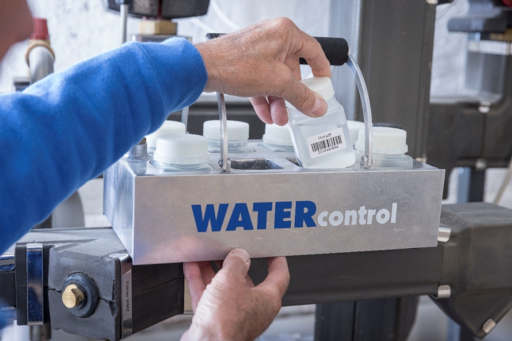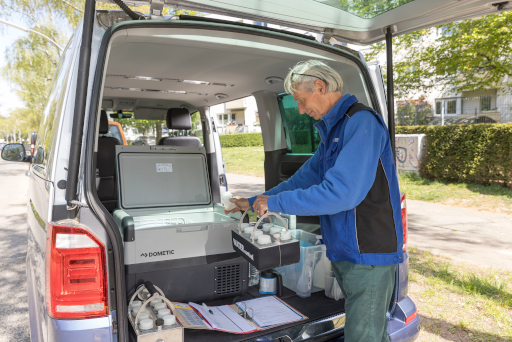 The water samples must be transported to the laboratory as quickly as possible after their collection – preferably within one day, but under no circumstances later than two days. If the samples are to be analyzed on the same day, it is sufficient to transport them protected from light and at ambient temperature. But which laboratory technician would want to accept, plate, and incubate 150 samples just before the end of the workday?
The water samples must be transported to the laboratory as quickly as possible after their collection – preferably within one day, but under no circumstances later than two days. If the samples are to be analyzed on the same day, it is sufficient to transport them protected from light and at ambient temperature. But which laboratory technician would want to accept, plate, and incubate 150 samples just before the end of the workday?
We have developed a two-stage cooling system, in which the samples are quickly cooled to ambient temperature immediately after collection using our passive cooling apparatus (PKA).
The pre-cooled samples are then kept cool in electrically powered cooling boxes inside the sample collection vehicles before being dispatched.
We are now faced with the following problem: In order to reach as many tenants as possible, it is advisable to carry out sampling until late in the evening. We do that and typically work until 7:00 PM in residential properties. However, the usual laboratory operating hours (outside of emergency management) typically end between 5:00 PM and 6:00 PM.
With that, it is clear: It requires overnight logistics with a documented cold chain to make all parties happy: tenants, laboratories, health authorities, and authors of DIN EN ISO 19458:2006. That technical regulation stipulates that the samples should ideally be stored at 5°C (± 3°C) if they cannot be delivered to the laboratory within 8 hours after collection.

In order to maintain this temperature range of 2 to 8°C, we have developed a so-called Passive Cooling Device (PCD) in collaboration with an engineering firm. The sample collector carries this device while working. The stainless steel construction is filled with very cold distilled water and quickly cools down the hot water sample containers to ambient temperature. The “cooling water” is changed two to three times a day. The apparatus can hold eight sampling bottles and weighs approximately five kilograms when fully filled.
The pre-cooled water samples are then further cooled to 5°C in an electrically operated cooling box in the vehicle until they are handed over to our external logistics partner or directly delivered to the laboratory by the sample collector. During overnight transport, our samples usually reach the sample reception at the laboratory the next morning. Sample acceptance and registration are typically carried out in the laboratory during the morning hours.
The twice-cooled water samples are finally shipped to the respective laboratory locations with water analytics (microbiology) in Styrofoam shipping boxes that have integrated cooling gel packs (placed under the lid). In the laboratory, the incoming temperature is recorded during sample acceptance. So, the entire path of the sample, including the cold chain, is easily traceable at all times. The maximum time window of 48 hours (for Legionella testing), between sample collection and further processing in the laboratory, is almost always adhered to.
Our two-stage cooling system has shown good and practical results in multi-story residential buildings, where we encounter accessibility challenges. Based on our experience, reaching tenants in the evening hours is significantly more effective than during the daytime. Indeed, overnight transport with uninterrupted cooling is a viable approach to minimize deviations from standard laboratory processes while still fulfilling the requirements of the Drinking Water Ordinance and relevant professional guidelines.
The cooling system is unique nationwide, and in the next generation of devices, it will be expanded to include a temperature logging function.

